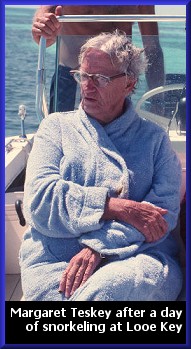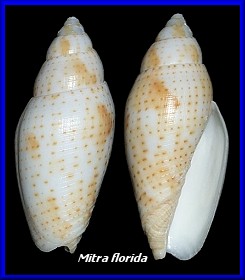| Reef Encounters Of The First Kind |
| By Phil Poland |
| When I returned to Florida after college,
I immediately went back to the snail hunting I’d enjoyed
years before. It was the early 1970's. I was back in the Keys, driving over a series of former railroad trestles. On this trip, I was following a tip about a collector who worked at Marathon Liquors who might help me get out to the reefs. I found the contact, and she in turn sent me to the Lower Keys Chamber of Commerce on Big Pine Key.
Margaret liked my appreciation of her specimens, but she liked the live Cittarium pica (Linnaeus, 1758) [West Indian Top Snail] I’d found and brought in even more. She’d never seen one in the Keys before. I was in my beginner’s luck phase. Margaret almost immediately invited me to join her for a snorkeling trip to Looe. "Just help pay for the gas." I think it was about $5 per-person. Toni Wood operated the Happy Turtle Boatel at the northwest end of Big Pine Key. It was little more than her house and accommodations for a few visitors, but superbly suited to the needs of visiting shellers. Toni’s boat looked pretty small. It was mid-morning when we headed south to pick up Margaret at her trailer park’s dock on Little Torch Key. Low tide at the reef was about 2:00 PM. Now a little about the reefs. Paralleling the line of the Keys is an offshore ridge of living coral. At Big Pine Key, it lies about nine miles south of US 1. At this ridge, the continental shelf ends, and deep oceanic water lies beyond it. At various points along its length, shallow or exposed areas allow for easy snorkeling and diving. These points include Looe Key. We picked up Margaret and headed south through Newfound Harbor Channel. The wind was a gentle breeze from the north and the water was smooth. Toni opened it up and we flew through one of the tiny bridge arches of the original Overseas Highway. Scared me to death! In a few minutes we were in Hawk Channel, between the Keys and the reef. About halfway across, the water became noticeably bluer. I was used to the muddy-green of inside waters. We saw flying fish, and a sea turtle popped up at one point. The water turned bluer and brighter. The pole that marked the Looe Key shallows came into view. It looked like a pile of rocks surrounded by the now patchy blue water. It was calm, and I was told that it was unusual to find it that way. We anchored on the north edge of the little island, the side facing the Keys. We had a short swim with our gear to the rocks. The rocks weren’t like those inshore. Coral slabs, chunks and coarse carbonate "sand" made up this little hump that was just now emerging from the ocean. Dead shells too.
The tide was still far from low. I followed the water’s edge by foot, covering new areas as the tide fell. Nerites gave way to species and forms I’d never seen before. Large and colorful Columbella mercatoria (Linnaeus, 1758) [West Indian Dovesnail] were found in clusters under the rocks. I’d never seen pink and orange ones. Probata barbadensis (Gmelin, 1791) [Barbados Miter], then my first live cowry, Erosaria acicularis (Gmelin, 1791) [Atlantic Yellow Cowrie] were found. The cowry wasn’t recognized until it retracted its mantle. Another nest of snails was found. What looked like a small handful of M&Ms under a slab turned out to be Tegula hotessieriana (d’Orbigny, 1842) [Caribbean Tegula] – red, brown, yellow and mixed. The related Tegula lividomaculata (C. B. Adams, 1845) [West Indian Tegula] was abundant under the rocks too. I began finding Caribachlamys sentis (Reeve, 1853) [Scaly Scallop] – orange, purple and white, and more cowries including Talparia cinerea (Gmelin, 1791) [Atlantic Gray Cowrie], I put on my mask and fins and went directly toward the open ocean. There was very little surf. More tumbled rocks and slabs. Sea fans came into view almost immediately. The water was only a few feet deep but already live coral was everywhere. I found out how fire coral got its name (As I’m writing this, I’m suffering from Poisonwood blisters from a much more recent Keys trip). The tide was dropping, and it was sometimes difficult to clear the live coral. The tumbled rocks gave way to the heart of the reef. Large and dramatic coral formations rose to the surface. Channels meandered through them like small canyons. Brilliantly colored fish circled the coral. The feeding plumes of worms burst like colorful feather dusters from holes in the coral. This was Technicolor! The slabs in this environment were not too productive. They were either chronically wave-tumbled or welded to the reef with coral. Lithopoma were here, covered with coralline algae. A few Cyphoma were found on the fans and whips. On later trips I’d learn how to find the Coralliophila snails among these corals. I retreated to the rocks. The most productive areas were not facing the reef and deep water, but at the sides of this little island. There, a mix of carbonate sand, rocks, slabs and marine grass, at a comfortable snorkeling depth, forms one of the richest habitats in Florida. It was there that I found my first Charonia, an orange one, the prize of my trip. In the "sand" under the slabs, the tops of Cypraecassis testiculus (Linnaeus, 1758) [Reticulate Cowrie-helmet) and Conus regius Gmelin, 1791 [Crown Cone] were uncovered with a sweep of the hand. Smaller species found clinging to the undersides of the slabs on this and subsequent visits would make a long list indeed. Among the genera found that day were Aspella, Daphnella, Tritonoharpa, Lucapina, Trivia, Volvarina, Calliostoma, Pisania, Favartia, Heliacus, Bursa, Bailya and many more. Typically, the larger the slab, the better the catch. Unfortunately, eels like it under there too. Margaret needed stitches after one trip. Behind the island, facing Hawk Channel, patchy grass is home to the conchs. Lobatus gigas (Linnaeus, 1758) [Queen Conch] were plentiful. S. raninus Gmelin, 1791 [Hawkwing Conch] and S. costatus Gmelin, 1791 [Milk Conch] were found too. Rocks were few behind the island but were worth turning. We spent hours snorkeling the fringes of Looe Key. In the early afternoon, we went gathered back at the boat for water, lunch and a break. The tide was at its lowest. On the reef itself, the tops of live coral and bent-over seafans were visible. The island was huge compared to the pile of rocks we’d found in the morning. Fields of sand, grass and rocks were bare and explorable without the use of snorkeling gear. And explore we did. Several Cymatium nicobaricum (Röding, 1798) [Goldmouth Triton] and large Calliostoma jujubinum (Gmelin, 1791) [Mottled Topsnail] were found as rocks were turned, along with more of the species we’d found earlier. Among the high intertidal rocks I’d ignored at the start, I found Fissurella angusta (Gmelin, 1791) [Narrow Keyhole Limpet], Arene cruentata (Mühlfeld, 1829) [Star Cyclostreme] and some very clean green and pink Carved Starsnails. By mid-afternoon we were sunburned and tired. The tide was coming in, and one by one we gathered at the boat. I snorkeled this relatively bare area to kill time and stay cool. Trails! Coarse as the sand was, there was no mistaking them. Together, the three of us got a dozen Olivella nivea (Gmelin, 1791) [Snowy Dwarf Olive] and two Hastula hastata (Gmelin, 1791) [Shiny Auger]. At the end of the day, each of us had a bag or jar of goodies in addition to various larger specimens wrapped in paper, shirts or towels, and stowed in buckets. We had our special prizes. Margaret had a monster Crown Cone, Toni had a small Cassis, and I had my Charonia. It had been a wonderful day, but we were pleased when the motor started. In subsequent years, returns to Looe and trips to other reef locations including Pelican Shoal, Sand Key and the Western Dry Rocks were often as productive, but this first encounter, and these first finds, will be my most memorable. Editor’s Comment: With the establishment of the Florida Keys National Marine Sanctuary in 1990, shell collecting in the above-described areas (excluding Pelican Shoal) was prohibited. |
 I found a very small building filled with trophies from Looe Key
(an exposed reef area south of Big Pine), and its operator,
Margaret Teskey.
I found a very small building filled with trophies from Looe Key
(an exposed reef area south of Big Pine), and its operator,
Margaret Teskey. One of the first
shells that caught my eye was a large dead Lithopoma caelatum
(Gmelin, 1791) [Carved Starsnail], almost never found on
Keys shores. The crabbed shells gave an indication of the diversity
there. Turbo canaliculatus Hermann, 1781 [Channeled Turban]
and even Dibaphimitra florida
(Gould, 1856) [Florida Miter], worn
and holed, were scuttling among the rocks.
One of the first
shells that caught my eye was a large dead Lithopoma caelatum
(Gmelin, 1791) [Carved Starsnail], almost never found on
Keys shores. The crabbed shells gave an indication of the diversity
there. Turbo canaliculatus Hermann, 1781 [Channeled Turban]
and even Dibaphimitra florida
(Gould, 1856) [Florida Miter], worn
and holed, were scuttling among the rocks.